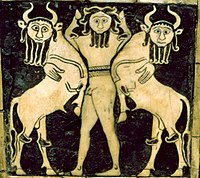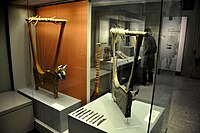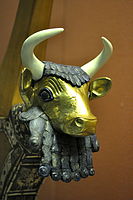Lyres of Ur

The Lyres of Ur or Harps of Ur are considered to be the world's second oldest surviving stringed instruments after the ones discovered in the Maykop culture.[1] In 1929, archaeologists led by the British archaeologist Leonard Woolley, representing a joint expedition of the British Museum and the University of Pennsylvania Museum of Archaeology and Anthropology, discovered the instruments when excavating the Royal Cemetery of Ur between from 1922 and 1934. They discovered pieces of three lyres and one harp in Ur, located in what was Ancient Mesopotamia and is contemporary Iraq.[2][3] They are over 4,500 years old,[4] from ancient Mesopotamia during the Early Dynastic III Period (2550–2450 BC).[5] The decorations on the lyres are fine examples of the court art of Mesopotamia of the period.[6]
Leonard Woolley discovered the lyres amongst the bodies of ten women in the Royal cemetery at Ur. One body was even said to be lying against the lyre with her skeletal hand placed where the strings would have been.[4] Upon this discovery, Woolley was quick to pour in a liquid plaster to recover the delicate form of the wooden frame.[7] The wood of the lyres was decayed but since some were covered in nonperishable materials, like gold and silver, they were able to be recovered.[8] Strictly speaking, three lyres and one harp were discovered, but all are often called lyres. The instrument remains were restored and distributed between the museums that took part in the digs.
Lyres[]
A lyre is a musical instrument that is stringed and has a role projecting from the body. There are two types of lyres: box and bowl. Like their names suggest, the box lyres have a boxlike body and the bowl lyres have a round body with a curved back. The Lyres of Ur are box lyres. They were played in an upright position with the strings plucked with both hands.[9]
Because of how they were discovered it is believed that the lyres were used in burial ceremonies in accompaniment to songs. Each lyre has 11 strings to play on that would produce a buzzing noise that repeated throughout the song. The musician playing the instrument would repeat the pattern displayed on the lyre.
The four lyres[]
The "Golden Lyre of Ur" or "Bull's Lyre" is the finest lyre, and was given to the National Museum of Iraq in Baghdad.[10] Its reconstructed wooden body was damaged due to flooding during the second Iraqi War;[11][12] a replica of it is being played as part of a touring orchestra.[2] The "Golden Lyre" got its name because the whole head of the bull is made of gold. The eyes are made of inlaid mother-of-pearl and lapis lazuli. The beard is similar in appearance to the "Great Lyre" and the "Queen's Lyre". The body of the bull was originally wood but did not survive. Its discoverer, Woolley, believes that unlike the other lyres, the body of the "Golden Lyre" would have originally had legs.[6]
The "Queen's Lyre" is one of two that Woolley found in the grave of Queen Pu-abi.[4] The "Queen's Lyre" is 110 centimetres (44 in) in height and is similar in appearance to that of the "Great Lyre".[13] The mask of the bull is gold. The eyes, hair, and beard are all made of lapis lazuli and the horns are modern. The shape of the lyre is meant to resemble a bull's body. A noticeable difference between the "Great Lyre" and the "Queens Lyre" is that the "Great Lyre" has a straight forehead where the "Queen's Lyre" curves slightly around the brow bone.[6] It is held in the British Museum.[4]
The "Bull Headed Lyre" is 40 cm in height, 11 cm in width, and 19 cm in depth. The shape of the lyre is meant to resemble a bull's body. Its head, face and horns are all wrapped in gold foil while its hair, beard, and eyes are made of lapis lazuli.[14] Below the head is a front panel made of shell inlay set into bitumen[15] This panel depicts a figure holding onto a bull's horns above, and animals acting as humans below. The bull head itself likely represents the sun god Utu/Shamash, who was thought to be able to descend into the underworld.[5] The lyre is held in the Penn Museum in Philadelphia.
The "Silver Lyre" is 110 cm (42 in) in height and 97 cm (38 in) in width. It is one of two silver lyres discovered in "The Great Death Pit". Both lyres were made of wood and then covered in sheets of silver that were attached with small silver nails. The eyes are made of lapis lazuli and the lyre was also trimmed with narrow borders of lapis lazuli. This is the only lyre that is not bearded. Because of this fresh face some believe it is actually a cow rather than a bull.
The Penn Museum also holds a silver boat-shaped Lyre.[14]
Gallery[]
The Queen's lyre and the silver lyre, from the Royal Cemetery at Ur, southern Mesopotamia, Iraq. The British Museum, London.
Bull's head of the Queen's lyre from Pu-abi's grave PG 800, the Royal Cemetery at Ur, Southern Mesopotamia, Iraq. British Museum
Cow's head of the Silver Lyre, from the Great Death Pit at the Royal Cemetery, Ur, southern Mesopotamia, Iraq. The British Museum, London

Master of animals motif in a panel of the soundboard of the harp

The Queen's Lyre from Wooley's published record

The Queen's gold lyre from the Royal Cemetery at Ur. Iraq Museum, Baghdad

Leonard Woolley holding the hardened plaster mold of the Sumerian Queen's Lyre, 1922
| Wikimedia Commons has media related to Lyres from Ur. |
See also[]
- Bull Headed Lyre of Ur
- Music of Mesopotamia
- 1929 in archaeology
- Kinnor, ancient Hebrew form of a lyre or kithara
- Nevel, ancient Hebrew form of a harp or nabla
References[]
- ^ Rezepkin, Alexej D. (2000). Das frühbronzezeitliche Gräberfeld von Klady und die Majkop-Kultur in Nordwestkaukasien. Archäologie in Eurasien (in German). 10. Verlag Marie Leidorf. ISBN 978-3896462596.
- ^ Jump up to: a b "Ancient Iraqi harp reproduced by Liverpool engineers". University of Liverpool. 28 July 2005. Archived from the original on 1 July 2010. Retrieved 2009-11-23.
A team of engineers at the University of Liverpool has helped reproduce an ancient Iraqi harp - the Lyre of Ur.
- ^ Golden Lyre of Ur Archived 2011-06-11 at the Wayback Machine, Bill Taylor
- ^ Jump up to: a b c d "Queen's Lyre". British Museum. Retrieved 2017-03-22.
- ^ Jump up to: a b "Lyre with Bearded Bull's Head and Inlaid Panel". With Art Philadelphia. Retrieved 2015-09-26.
- ^ Jump up to: a b c Aruz, J. & Wallenfels (2003). Art of the First Cities: The Third Millennium B.C. from the Mediterranean to the Indus. New York: The Metropolitan Museum of Art.
- ^ "The Lyre of Ur, Carl McTague". www.mctague.org. Retrieved 2015-09-26.
- ^ Lawergren, Bo (November 2005). "Two Lyres from Ur". Bulletin of the American Schools of Oriental Research. Retrieved October 21, 2015.
- ^ "Encyclopedia - Britannica Online Encyclopedia". academic.eb.com. Retrieved 2015-10-29.
- ^ "lyre-of-ur.com". lyre-of-ur.com. Retrieved 2014-03-17.
- ^ Matthew Bogdanos. "The Casualties of War: The Truth about the Iraq Museum | American Journal of Archaeology". Ajaonline.org. Retrieved 2014-03-17.
- ^ Carl McTague. "The Lyre of Ur, Carl McTague". Mctague.org. Retrieved 2014-03-17.
- ^ "Lyres from The Royal Tombs of Ur". sumerianshakespeare.com. Retrieved 2015-09-27.
- ^ Jump up to: a b "Two Lyres from Ur, Maude de Schauensee". Upenn.edu. Retrieved 2014-03-17.
- ^ Greene, Virginia (2003). "Conservation of a Lyre from Ur: A Treatment Review". Journal of the American Institute for Conservation. 42 (2): 265–270. doi:10.2307/3180072. JSTOR 3180072.
- 3rd-millennium BC works
- 1929 archaeological discoveries
- Ancient music
- Archaeological discoveries in Iraq
- Individual harps
- Middle Eastern objects in the British Museum
- Objects in the National Museum of Iraq
- Ur
- Sculpture of the Ancient Near East
- Early Dynastic Period (Mesopotamia)






